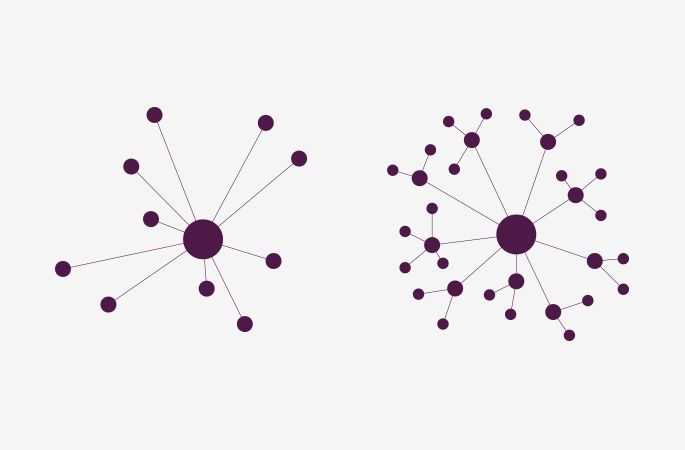
The Great Social Media Experiment
Lessons learned? Is Crypto-based “Decentralization” the Solution or a Bigger Problem?
We have learned a lot in the last decade when it comes to social media; it is increasingly the space where individual identity is shaped, and where we practice social constitution, and political determination. However, not much of this is seen through the lens of the platform architecture. In fact, while examinations from psychological, sociological, political, and market force perspectives have proven essential to uncovering hidden effects, an understanding of platform architecture – and specifically its latent subjectivities – remains relatively less considered. This paper begins to address those subjectivities to help chart a path forward. This paper also addresses the next generation of “decentralized” block-chain based alternatives, being built now at blazing speeds and massive budgets, in which blind spots in design have potentially only grown bigger. Among the conclusions is that, if we continue down the path of crypto-based “decentralization,”, there may not be a single vendor to point to, or an “off switch” to which we can turn.
Among the conclusions is that, if we
continue down the path of cryptobased “decentralization,”, there may not be a
single vendor to point to, or an “off switch”
to which we can turn
Conceptualizations of Social Relations
One way to understand how a platform affects its users is to examine its various features. In the case of social media, the features are the various conceptualizations of human relations. For example, Twitter conceptualizes a network of Followers and Tweets; Facebook conceptualizes Friends and Personalized News Feed (also, Pages, Groups, etc.), while Foursquare conceptualizes gamified social relations tied to places, including the conceptualization of a Mayor of a place (e.g. I could be the Mayor of my local coffee shop). Functionally, these conceptualizations are product features that can be assessed for their attractiveness and usefulness to users. This is what product managers have developed methodologies and tools for, and end up doing on a daily basis, both qualitatively and also empirically by testing changes to the platform on small populations.
While there is an aspect of the conceptualization that is visible to the users, there are hidden aspects as well. For example, a product conceptualization such as Personalized News Feed, is in fact quite complex in terms of the functionality that it provides, based as it is on AI-based ranking algorithms that examine social interactions and predict behavior. The content, of course, may also have profound effects, affecting both social relations, and altering users’ views on various topics in the world at large. While the hidden functionality may be designed to serve the users, we know it is also used to serve vendors and advertisers. An example demonstrating the conflicting interests includes, among others, Facebook’s refusal to allow users to turn the newsfeed ranking algorithm off, despite continuous user backlash since the first day it launched in 2006. To date, an updated feature that sorts the news feed by recent posts works for only 12 hours until the ranking algorithm resumes full control once again.
Centralized vs Decentralized networks

Most conceptualizations also have a semantic and/or ideological dimensions, which further affect users. Even as the Personalized News Feed offers up a world that is “just right” for me, resonating with a highly individual-focused worldview, it is still also “News”. All at once it therefore resonates equally with traditional conceptualizations of “News” as a shared space, which facilitates the constitution of shared worldviews.
As we spend more time online within any platform, the platform’s social logic starts pushing aside other potential conceptualizations. This is already well understood: As AI is harnessed towards growth and profitability, alternative conceptualizations that have not been codified begin to disappear. What is less well understood is that the platform architecture design process is as varied as the individuals engaged in it. And while regulators might try to affect change, it is not quite a root-cause solution to the unevaluated and subconscious assumptions made during the design process, which in turn are important to understanding platform effects.
As we spend more time online
within any platform, the platform’s
social logic starts pushing aside
other potential conceptualizations
Existing Blindspots
Underlying assumptions can generally be gleamed through the semantic choices made by the designers, such as ‘Friends’, ‘Like’, or ‘Group.’ Others may be identified through a user’s own self-reflection. As powerfully, we have become accustomed to rating and being rated. Many of us are also aware of some lurking excitement or angst in anticipation of a post going ‘viral. We may have also experienced tremendous life changing experiences online. At times it seems as though any form of human expression or interaction can take place online. The reality, however, is that there is a uniform, strict, and often hidden, logic.
What is this and how does it happen? How does the software architecture process shed light on the loss of shared space, the loss of a sense of place? First, it begins with platforms that share a common conceptualization of human relations as an act of information transfer, or content that’s sent or posted. While developers naturally think of communication as sending packets across the network, human relations so conceptualized as information transfer becomes content that calls to be ranked. Ranking then becomes the key to operating an ‘economy of content’. Ranking provides measurability and metrics, becoming the force justifying its own market economy. These same metrics become success indicators optimizing a company’s growth.
Personalization is another common conceptualization that informs the experience on the platform, one which has been a theme running through the software industry for the last two decades. This relates to software’s ability to sort through the world of information, and pick and choose information that’s relevant for a specific user, for a specific need or in a specific context. In addition to offering users a view of the world unique to them, it also drives a tension between engagement-associated revenue and a meaningful social experience instantiated in shared space.
An additional limitation based on the underlying architecture is the overall uniformity of any given platform. This again has to do with monetization, and the imperative to set standards for content, format, and placement. This was evident in the earlier days of social media, as beloved platforms which offered customization like MySpace nevertheless failed to monetize effectively. It is also exemplified in Facebook’s global terms of service, which fails constituents by banning forms of nudity considered normative in their societies.

In summary, seen from the perspective of software design, social media has become forged in the caldron of instrumental information transfer, content ranking, and personalization. This together has been delimited both by the single or multiple software architect’s conscious intent, and by unconscious assumptions about the world, reflecting and amplifying the specific slice of society in which it was conceived. Regulatory change may be useful, but the root cause of any fix lies at least in part at the level of platform development.
Future Blindspots
The big question for the next generation of platform technologies is how and to what extent they address the blindspots of today’s social media? While there are many alternatives and often contradictory visions being discussed and pursued, a common theme is that of “decentralization”. The other is virtual reality (VR) and augmented reality (AR).
Decentralization refers to the use of blockchain, often in conjunction with a cryptocurrency. These are constructs of computer code, that when executed on multiple networked machines result in a single distributed shared undisputable repository of information. When used in conjunction with a cryptocurrency, the distributed shared ledger is used to maintain the list of undisputed transactions, and the currency is used to organize people and resources to ensure the system works.

What is important from a design perspective is that this new class of technologies can be thought of as a technologically-enabled socio-economic construct able to codify social and economic relations. In this they follow from past challenges in carrying a semantic and ideological component, even as increased complexity means they may be harder to decipher. For example, the algorithms employed are referred to as “consensus algorithms”, which are then justified by being the logic which forges agreement. At the core, therefore, a technical process relying on distributed nodes to prevent the hacking or hijacking of a system becomes its own self-validating way to create meaning.
Another semantic and ideological component used to describe these systems is that of ‘trustless’, or ‘zero trust’. When thought of instrumentally to achieve economic goals such as moving money around, or technological goals such as establishing a truly distributed computing environment, ‘trustless’ or ‘zero-trust’ is a powerful feature with desirable outcomes. While the blockchain is not a trustless system, it does distribute trust amongst many participants, so that the trust and agency required of any one individual is very low and the functionality is without what we think of as centralized control. In this techno-utopian dream of an individual-centered, instrumental, self-regulating life, ‘trustless’ decentralization of payments can be just the first step towards no government at all, including potentially no need for social constitution, or political deliberation.
By peeling off the semantic and ideological layers of the system components, what emerges veers towards an instrumental socio-economic system based on market or monetary logic. The same decentralization that may shift power away from the cloud vendors towards individual computer nodes may in parallel ultimately centralize control into the hands of the code writers and vendors that control that same powershift. The utopia falls apart very quickly when a software update of a blockchain-based system is required. Who is making the decisions then? Will an update focusing on reducing energy consumption?
By peeling off the semantic and ideological layers of the system components, what emerges veers towards an instrumental socio-economic system based on market or monetary logic
Or reducing transaction costs to enable micro-payments? Who will be making these policy decisions? A coder able to reply with something akin to “in code we trust” is clearly not an acceptable outcome.
Conclusion
If social media was a great social experiment designed to warn us of the dangers of the economization of the social and political realm, it worked. Addressed from the perspective of a software developer, this paper points to aspects of the economization of social media that are only visible when viewed from the perspective of software design.
From the perspective of the design process, we’ve seen how social media platforms reproduce the conceptualizations of the social world that are codified into them, onto the world of their users. We’ve seen how that includes both explicit intents, but also the latent subjectivities of the creators, including their many unevaluated assumptions about the world. We’ve also seen how a conceptualization may have one ‘face’ for the users, and another hidden ‘face’ to serve the vendor or advertisers, often at odds with one another. Lastly, we’ve seen how encryption-enabled constructs such as the blockchain and cryptocurrencies represent a leap forward in both complexity and power, with their effects on society paradoxically even harder to decipher and predict.
All of the above may indicate that a remedy that does not lead to a rethinking of the design process itself will necessarily be incomplete. Regulatory bodies such as the FTC and others around the world can offer only a partial remedy if they continue apace. However, structural change that would allow a multitude of designs to materialize within the context of the of societies, communities, age groups, political orientation, or special needs that the designs serve could be a potential remedy. This means opening up the platform and its business model so that other entities (both private and public sector) that can create their own modules, experimenting with different forms of social organization, monetization, governance, markets, commons, and so on. This would allow society at large to gradually regain its agency, while confining instrumentality and market logic to where it’s needed.
If we fail to do this, our world risks becoming ever more homogenous with economic and financial instrumentality reigning supreme. Otherwise, the rush of new massively funded social media developments promising to save the day through “decentralization” and virtual or augmented reality will only shift power while ultimately recentralizing it. In such a scenario, the codified world view which will get reproduced will likely be an even more anti-social anti-democratic version of the previous generation.
